John Brown (1805–1876) was a 19th-century architect working in Norwich, in the county of Norfolk, England. His buildings include churches and workhouses.

The Leeds Corn Exchange is a shopping mall in Leeds, West Yorkshire, England. The structure, which was commissioned as a corn exchange, is a grade I listed building.

The Corn Exchange is an events and concert venue located on Wheeler Street in Cambridge, Cambridgeshire, England. The structure, which was commissioned as a corn exchange, is a Grade II listed building.

The Hazlitt Theatre and Exchange Studio, also known as the Hazlitt Arts Centre, is a theatre complex in Earl Street in Maidstone, Kent, England. The oldest part of the complex, which is now used as a shopping complex on the ground floor, and as a theatre venue known as the "Exchange Studio" on the first floor, is a Grade II listed building.

Leicester Corn Exchange is a commercial building in the Market Place in Leicester, Leicestershire, England. The structure, which currently operates as a public house, is a grade II* listed building.

The Corn Exchange is a commercial building in Cornhill, Bridgwater, Somerset, England. The structure, which is now used as a shopping arcade, is a Grade I listed building.

Corn exchanges are distinct buildings which were originally created as a venue for corn merchants to meet and arrange pricing with farmers for the sale of wheat, barley, and other corn crops. The word "corn" in British English denotes all cereal grains, such as wheat and barley. With the repeal of the Corn Laws in 1846, a large number of corn exchanges were built in England, particularly in the corn-growing areas of Eastern England.

Harleston is a town 16 miles (26 km) from Norwich, in the civil parish of Redenhall with Harleston, in the South Norfolk district, in the county of Norfolk, England. In 2018 it had an estimated population of 5067. Harleston is on the Norfolk/Suffolk border, close to the River Waveney. Harleston has 2 markets every Wednesday.

The Old Town Hall is a former events venue in Prince of Wales Road, Cromer, Norfolk, England. The structure, which is currently used for retail purposes, is a grade II listed building.

The Corn Exchange is a commercial building in the Market Place in Saffron Walden, Essex, England. The structure, which is currently used as a library, is a Grade II listed building.

The Corn Exchange is a commercial building on Fore Street in Hertford, Hertfordshire, England. The structure, which is currently used as an events venue, is a Grade II listed building.

The Corn Exchange is a commercial building in Tuesday Market Place, King's Lynn, Norfolk, England. The structure, which was commissioned as a corn exchange and is now used as an events venue, is a Grade II listed building.

The Corn Exchange is a commercial building in Queen Street, Market Rasen, Lincolnshire, England. The structure, which is used as the offices of a firm of charted surveyors, is a Grade II listed building.

The Corn Exchange is a commercial building in The Pantiles, Royal Tunbridge Wells, Kent, England. The structure, which is currently used as an antiques and fine art market, is a Grade II listed building.

The Corn Exchange is a commercial building in the Market Place, Fakenham, Norfolk, England. The structure, which is currently used as a cinema, is a Grade II listed building.

The Corn Exchange is a commercial building on Market Hill, Sudbury, Suffolk, England. The structure, which is used as a public library, is a Grade II* listed building.

Tunsgate is a neoclassical style building in Guildford, Surrey, England. The structure, which was originally a corn exchange and now forms the entrance to a shopping centre, is a Grade II listed building.

The Corn Exchange is a commercial building in Angel Street, Worcester, Worcestershire, England. The structure, which is currently vacant, is a Grade II listed building.

The Corn Hall is a commercial building in the Market Place, Swaffham, Norfolk, England. The structure, which is used as offices and as a coffee house, is a Grade II listed building.

The Corn Hall is a commercial building in St Nicholas Street, Diss, Norfolk, England. The structure, which is now used as an arts centre, is a Grade II listed building.




















